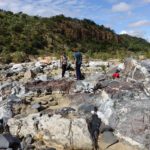A ‘toad-break’ area devoid of water needed by cane toads to survive will be used to prevent the invasive species from infiltrating the Pilbara region and protect its 27 million hectares of sensitive habitat, significant Aboriginal cultural heritage and native wildlife.
The WA State Government today announced funding for the first phase of the Toad Containment Zone (TCZ), which is a collaborative project involving traditional owners, rangers, pastoralists, and scientists from Curtin University, Deakin University, Rangelands NRM, Nyangumarta Warrarn Aboriginal Corporation and Karajarri Traditional Lands Association.
Professor Ben Phillips from Curtin’s School of Molecular and Life Sciences said the containment zone, on the edge of the Great Sandy Desert, aimed to halt the spread of cane toads south from the Kimberley and prevent the ecological damage they have caused in other regions.
“Developed from more than a decade of scientific research, the TCZ was a key recommendation from the 2019 Federal Senate Inquiry and a priority action in both Nyangumarta Warrarn and Karajarri Indigenous Protected Area plans,” Professor Phillips said.
“By removing access to water at 150 man-made water points in a narrow coastal strip – or ‘toad-break’ – between the Kimberley and the Pilbara, the project aims to create an effective barrier against the toad invasion.
“Toads invade by steadily moving across the landscape in the wet season, but they need water points to survive the long, hot dry season. Without access to water, toads in the containment zone will perish, effectively stopping their advance.
“With cane toads currently less than 150km from Broome and projected to reach the containment zone by the 2027/2028 wet season, the urgency to implement this plan is critical. The TCZ, once rolled out by Nyangumarta and Karajarri ranger groups and Rangelands NRM, will serve as vital biodiversity protection infrastructure.”
NRM Rangelands Manager Chris Curnow said the initiative was a once-in-a-lifetime opportunity to prevent an ecological catastrophe across the entire Pilbara.
“Ever since the idea of the toad break arose nearly 10 years ago, the Nyangumarta and Karajarri traditional custodians have been on board guiding and informing the way ahead,” Mr Curnow said.
“Their knowledge of the area has helped pinpoint the various water sources and have guided scientists as to where the zone will have its best chance of success.”
Professor Tim Dempster from Deakin University said cane toads were introduced to Australia in the 1930s and had since spread across the tropical north.
“We now have a chance to halt this invasion in its tracks and avoid seeing the Pilbara and its incredible gorge country and waterways full of toads, the region’s native animals threatened and the loss of bush tucker,” Professor Dempster said.
“We are grateful to the WA State Government for supporting this important community-led initiative.”
For more information visit website www.toadfree.zone and this press pack includes an animation explaining the TCZ, a map of its location and images of species threatened by a potential cane toad invasion in the Pilbara.



